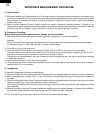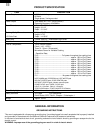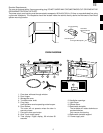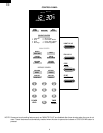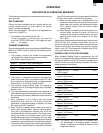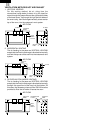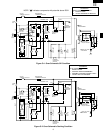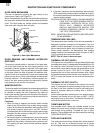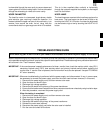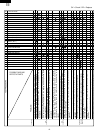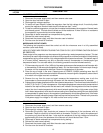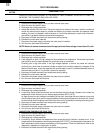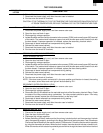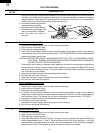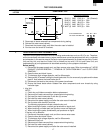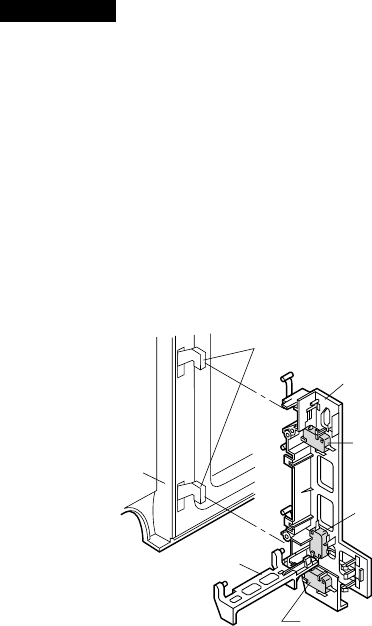
10
R-1500
R-1501
R-1505
R-1506
DESCRIPTION AND FUNCTION OF COMPONENTS
3. If the door is opened, and the secondary interlock relay
(RY2) and primary interlock switch contacts fail to open,
the monitor fuse blows simultaneously with closing of the
monitor switch contacts.
CAUTION: BEFORE REPLACING A BLOWN MONITOR
FUSE TEST THE DOOR SENSING SWITCH,
SECONDARY INTERLOCK RELAY (RY2),
RELAY (RY1), PRIMARY INTERLOCK
SWITCH AND MONITOR SWITCH FOR
PROPER OPERATION. (REFER TO CHAP-
TER "TEST PROCEDURE").
NOTE: MONITOR FUSE AND SWITCH ARE REPLACED
AS AN ASSEMBLY
TEMPERATURE FUSE (MG)
The temperature fuse located on the fan duct assembly is
designed to prevent damage to the magnetron if an over
heated condition develops in the tube due to cooling fan
failure, obstructed air guide, dirty or blocked air intake, etc.
Under normal operation, the temperature fuse remains
closed. However, the temperature fuse will open at 302˚F
(150˚C) causing the oven to shut down.
NOTE: This is a fuse. It does not reset.
THERMAL CUT-OUT (HOOD )
This thermal cut-out located on the right base plate flange
(turntable motor side). It is designed to automatically turn on
the hood fan motor whenever the hot air rising from the
conventional range below causes the temperature at the
thermal cut-out to rise to 140˚F (60˚C) or higher, thus
removing this hot air from around microwave oven. When
the temperature around the thermal cut-out drops to 113˚F
(45˚C) or lower, the thermal cut-out shuts off the hood fan
motor.
THERMAL CUT-OUT (CAVITY )
This thermal cut-out is located on the bottom of the oven
cavity. It is designed to prevent damage to the oven unit if
the food in the oven catches fire due to overheating pro-
duced by improper setting of cooking time or failure of
control unit.
Under normal operation, the thermal cut-out remains closed.
However, the thermal cut-out will open at 293˚F (145˚C)
causing the oven to shut down. The defective thermal cut-
out must be replaced with a new one.
TURNTABLE MOTOR
The turntable motor rotates the turntable located on the
bottom of the oven cavity, so that the foods on the turntable
cook evenly during cooking. Turntable will turn in either
direction. The turntable motor can be turned off by touching
TURNTABLE ON/OFF pad.
COOLING FAN MOTOR
The cooling fan motor drives a blade which draws external
cool air. This cool air is directed through the air vanes
surrounding the magnetron and cools the magnetron. This air
DOOR OPEN MECHANISM
The door is opened by pushing the open button on the
control panel, refer to the Figure D-1.
When the open button is pushed, the open button pushes up
the open lever, and then the open lever pushes up the latch
head. The latch heads are moved upward and released
from latch hook. Now the door will open.
Figure D-1. Door Open Mechanism
DOOR SENSING AND PRIMARY INTERLOCK
SWITCHES
The primary interlock switch is mounted in the lower posi-
tion of the latch hook and the door sensing switch in the
secondary interlock system is mounted in the upper posi-
tion of the latch hook. They are activated by the latch heads
on the door. When the door is opened, the switches inter-
rupt the circuit to all components. A cook cycle cannot take
place until the door is firmly closed thereby activating both
interlock switches. The secondary interlock system con-
sists of the door sensing switch and secondary interlock
relay located on the control circuit board.
MONITOR SWITCH
The monitor switch is activated (the contacts opened) by the
latch head on the door while the door is closed. The switch
is intended to render the oven inoperative by means of
blowing the monitor fuse when the contacts of the second-
ary interlock relay (RY2) and primary interlock switch fail to
open when the door is opened.
Functions:
1. When the door is opened, the monitor switch contact
close (to the ON condition) due to their being normally
closed. At this time the secondary interlock relay (RY2)
and primary interlock switch are in the OFF condition
(contacts open) due to their being normally open contact
switches. And the contacts of relay (RY1) are in the ON
condition (contacts close).
2. As the door goes to a closed position, the monitor switch
contacts are first opened and then the door sensing
switch and the primary interlock switch contacts close.
(On opening the door, each of these switches operate
inversely.)
Latch hook
Door sensing
switch
Latch heads
Monitor switch
Primary interlock switch
Open lever
Door



